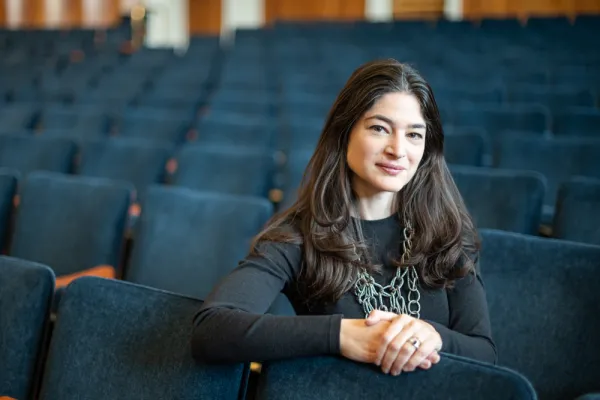New Office of the Arts Takes Center Stage
Smith Arts
Inaugural director says the arts help educate the ‘whole person’

Published December 9, 2022
The arts have always been integral to the Smith experience—from stellar student a cappella groups to the renowned Smith College Museum of Art. With the recent creation of the Office of the Arts at Smith College, Leigh Fagin, the inaugural Jean and David W. Wallace Foundation Director, believes even more opportunities will emerge for students to engage with the arts in a variety of meaningful ways. Under Fagin’s leadership, the office will serve as a hub for information about the arts at Smith.
Before arriving at Smith in August, Fagin—a Wellesley alum—served as senior director of programming and engagement for the Reva and David Logan Center for the Arts at the University of Chicago, where she led collaborative arts programs that contributed to the creative culture at the university, while supporting the work of students and faculty. At Smith, Fagin is excited about acting as an ambassador and advocate for the arts on campus and co-creating new programs to engage students from all academic disciplines in the production and performance of art. Here, Fagin discusses getting to know Smith and building the arts office from the ground up.
What are your initial impressions of Smith?
I have so enjoyed getting to know the creative spirit of this place, and it’s exciting to be involved with building a new office that informs, supports, and advances arts scholarship, creation, and engagement in collaboration with students, staff, and faculty at Smith. Being an alum of a women-centered institution, I see my values reflected in the student body, and am inspired to amplify and strengthen the arts ecosystem on campus.
What have you learned so far about the role of the arts at Smith?
The producing and performing arts play an important role in the intellectual and cultural aspirations of the college and the education of the whole person. At Smith, the arts have a long history of helping students generate a sense of belonging, encouraging them to think creatively, encouraging diverse perspectives, developing new habits of the mind, and offering new modes of discovering one’s voice. From the art museum’s vast collection to the outstanding artists and scholars on faculty to the countless arts and culture student groups—Smith is committed to bold and innovative thinking and hands-on learning through the arts.
It is still early, but can you share some of the hopes and dreams you have for the Office for the Arts.
I believe my experience in collaborative programming and arts administration in higher education will help me build on the legacy of the arts at Smith. I hope to bring an innovative approach to how all the pieces of the arts at Smith can work together. Through new resources and facilitating meaningful partnerships, we can better facilitate and promote the work of students, faculty, and staff and increase connections with the greater campus community.
What are some of your long- and-short-term program priorities?
Over the next few months, I look forward to speaking with more faculty, students, and staff within and beyond the arts and on- and off-campus, to assess shared priorities and challenges and opportunities for interdisciplinary work that can enhance the curriculum. After determining a mission and vision for the office, I hope to pilot some programs that allow us to raise the visibility of the arts at Smith, to incentivize collaboration and build capacity to support and deepen the impact of successful programs and new ideas, as well as develop new pathways for students pursuing careers in the arts.
How else will the Office for the Arts benefit students?
I hope we can help build community for those currently studying, creating, and enjoying art on campus. By making visible all the opportunities to engage, focusing on access to existing and new opportunities, and strengthening the presence of art and artists on campus, students can discover new avenues for advancing their creativity in ways that will enrich their future, no matter what field they pursue.
Why are the arts so important on college campuses?
Artists and scholars foster experimentation and risk-taking and inform scholarship that has the power to illuminate and advance local, national, and global conversations. The arts have always been a place for students to find and share their voice, to express concerns and discoveries about the world around them, and to foster community among makers through collaborative and innovative thinking.
Photograph by Jim Gipe